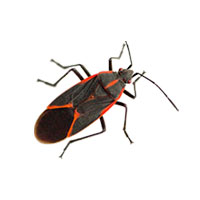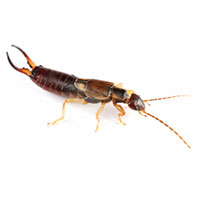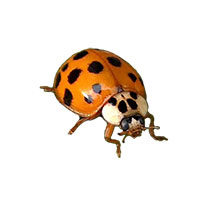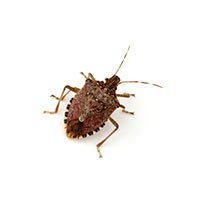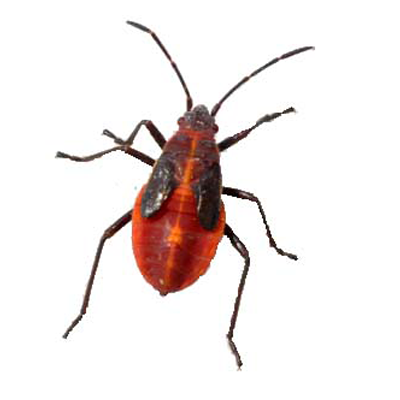
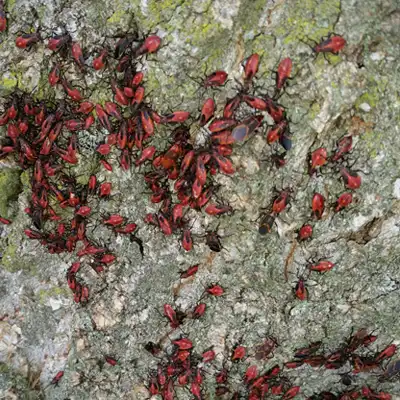
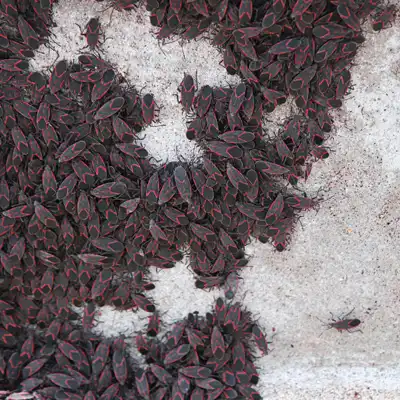
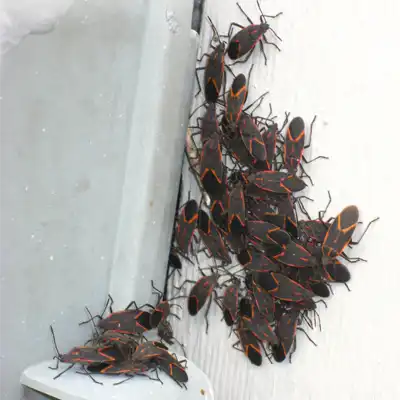
Boxelders in Wisconsin
The boxelder bug frequently becomes a nuisance pest around homes and buildings near boxelder trees. In heavily infested areas, they sometimes are associated with ash and maple trees.
Boxelder Bug Diet
Named for their primary plant host, the boxelder tree, boxelder bugs feed on a variety of plant life, including boxelder tree seeds, boxelder tree fruits, plants, maple trees, apples, pears, peaches, strawberries.
Boxelder Bug Habitat
Mainly a nuisance pest to homeowners, the insect becomes an irritant by attempting to overwinter in man-made structures. Overwintering occurs in large numbers around building foundations and ground-floor windows. They gather on the south and west sides of buildings when the sun heats exposed surfaces. Even though they regularly seek shelter indoors during the colder months, boxelder’s will not reproduce or feed inside human habitations, despite the common fears of homeowners.
Boxelder Bug Life Cycle
Between April and May, the bugs emerge from hibernation. Around the same time, the buds on boxelder trees begin opening, and the insects fly back to host trees where they remain active over the growing season.
Eggs
Eggs are typically laid in the cracks and crevices of boxelder tree bark in the spring.
Nymphs
After hatching, the emergent box elder nymphs feed on foliage and seeds by inserting their piercing-sucking mouthparts into the tissue of the seeds of the tree. The developing insects pass through five instars before fully maturing, with two separate generations usually produced each year.
Boxelder Bug Damage
- Nuisance: Though boxelder bugs do not bite, cause structural damage, or eat human foods when overwintering indoors, the mere presence of the insects may become a nuisance to homeowners.
- Stains: If squished, the boxelder bug may leave an unsightly stain.
- Plants: The feeding habits rarely result in significant damage to the host plant, though larger infestations may become more noticeable as they feed large amounts of food.
Signs of an Infestation
Warmth
Look for boxelder bugs congregating on south-facing walls with direct sunlight in search of heat as the months get colder. When looking for heat, the boxelder bug may enter homes as the weather worsens.
Openings
Indoors, the pests are often seen around windows and doors.
Boxelder Trees
Boxelder trees on the property will attract insects.
Boxelder Bug Prevention & Control
Boxelder Bug Prevention
The best course of action to stop boxelder’s from entering the home is to take preventative measures. This includes:
- Covering vents
- Repairing window and door screens
- Caulking openings in the foundation and around plumbing, electrical conduits, and windows
- Wood piles, overgrown plants, and mulch placed too close to the home may provide hiding places for the pests
Boxelder Bug Control
DIY Control
- Don’t crush them! Avoid stepping on or squashing the boxelder bug, as the insect may stain carpets, other fabrics, or walls.
- Vacuum! Simply vacuuming the insect up may prove effective.
- Prevention is the key, so caulk and close up window and door frame gaps, and any other openings into the building.
Professional Pest Control
Your Batzner Service Specialist will come to your property to identify the source of the boxelder bugs and determine the proper treatment method. Fall is the time to help prevent boxelder bugs from using your building or home as a refuge for the coming winter season. With the onset of cooler temperatures in autumn, these insects congregate on buildings in search of overwintering sites. To prevent pest entry, treatment must be applied before the insects begin to enter buildings during late September or early October to be effective. Once the pests have entered the building, treatments can be done in winter or spring. The most effective pest management option is prevention. Prevention is the key!
Need help with Boxelder bugs?
We'll call you! Leave your information below.

